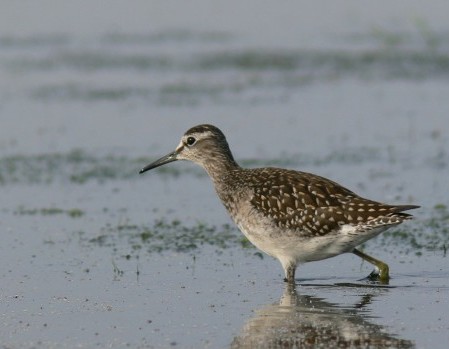Remisiewicz M., Tree A.J., Underhill L.G., Burman M.S. 2016. Age-specific variation in relationship between moult and pre-migratory fuelling in Wood Sandpipers Tringa glareola in southern Africa. Ibis 159: 91–102. DOI: 10.1111/ibi.12436[/vc_column_text][/vc_column][vc_column column_padding=”no-extra-padding” column_padding_position=”all” background_color_opacity=”1″ background_hover_color_opacity=”1″ width=”1/3″]
[vc_column_text]Wood sandpiper, phot. M. Ściborski
[/vc_column_text][/vc_column][/vc_row][vc_row type=”in_container” scene_position=”center” text_color=”dark” text_align=”left” overlay_strength=”0.3″][vc_column column_padding=”no-extra-padding” column_padding_position=”all” background_color_opacity=”1″ background_hover_color_opacity=”1″ width=”1/1″][vc_column_text]The study describes the relationship between the moult of flight feathers and pre-migratory fuelling at the non-breeding grounds in southern Africa, using long-distance migrant Wood Sandpipers as an example. These relationships differ between adult and immature birds. The paper presents statistical methods and models that can be used to determine the time when migratory birds begin fuelling before departure from the non-breeding grounds and in relation to the birds’ stage of moult. The study showed that adult Wood Sandpipers moult wing feathers and fuel slowly, with a break between these processes. They begin fuelling in February, well before their departure in mid-March. But inexperienced immature Wood Sandpipers resort to a plethora of strategies: some birds moult and fuel slowly, but others moult and fuel simultaneously and rapidly, at the “last minute” before their departure.The study resulted from collaborative research between the authors in Poland and South Africa, as well as mutual research visits. It was part of the project “Building an Early-Warning System for Biodiversity in the Face of Development and Climate Change” funded by NCBiR (Poland) and NRF (South Africa) within the programme of Poland-South Africa scientific collaboration.
Enjoy reading the paper at:
http://onlinelibrary.wiley.com/doi/10.1111/ibi.12436/full[/vc_column_text][/vc_column][/vc_row]




